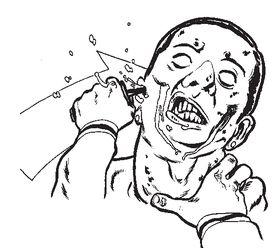The Zombie Combat Manual (31 page)
Read The Zombie Combat Manual Online
Authors: Roger Ma

The first rule of conventional weapon-disarming tactics is to control the weapon itself. Once you negate the weapon’s advantage, your opponent becomes much less of a threat. This is no different when engaging in close-combat with the undead. In these cases, the primary weapon you must manage is the zombie’s bite. If you are able to effectively keep a ghoul’s mouth from snapping at you, you provide yourself valuable time to draw your weapon and deliver your own lethal blow.

THE FULL THROTTLE
TARGET AREA: NECK/THROAT REGION
Technique:
Grab the zombie with your nondominant hand by the top of the neck, directly below the chin. Using your thumb and forefinger, forcefully squeeze the soft tissue alongside the throat (the Adam’s apple on a male zombie). This will enable you to keep the zombie’s mouth at a distance from your body, while also forcing it slightly shut from the pressure you exert on the mandible. Grabbing near the top of the throat also prevents the ghoul from craning its neck down and taking a chunk out of your wrist or forearm. This maneuver can also set the stage for the two techniques described next.
MIDDLE CRANIAL FOSSA (MCF) ATTACK
TARGET AREA: UNDERSIDE OF CHIN, SOFT PALATE, BRAIN
MOST EFFECTIVE WITH: EDGED WEAPONS (COMBAT KNIVES, CHEF’S KNIVES,
SCREWDRIVERS)
Technique:
The MCF attack is identical to the Kabob technique described in long-range combat techniques, the obvious difference being the distance at which it is executed. This technique is by far the most effective method for ending a close engagement quickly. The middle cranial fossa area of bone is the thinnest on the entire skull and can be easily targeted during ZCQC. It does, however, require that you move quickly and without hesitation:
1. Draw your weapon from its sheath (ideally mounted on your chest in the cross-draw position).
2. Position the weapon so the point rests directly under the ghoul’s chin.
3. Drive the weapon straight up through the jaw into the brain. You will feel resistance once you puncture the soft and hard palates, and finally reach the brain. Keep driving the weapon upward.
4. Forcefully retract your weapon to avoid catching it in the skull cavity.
5. Push the zombie away so its carcass does not fall on your body.
THE Q-TIP
TARGET AREA: EAR CANAL
MOST EFFECTIVE WITH: SPIKED WEAPONS (ICE PICKS, TRENCH SPIKES, AWLS)
Technique:
An alternative target during a close-quarters encounter is the ear canal. This technique, however, should be attempted only when using a weapon suited to penetrating this specific orifice. The weapon should be long and thin with a stabbing point, such as an ice pick or trench spike. An improvised weapon such as a screwdriver or scratch awl is also effective. A combat knife is
not recommended
for this technique. The flat, wide blade of a traditional edged weapon may have greater difficulty driving through the canal into the brain. The attack sequence is similar to that of the MCF technique, except for the target area on the zombie cranium:
1. Draw your weapon and position it outside the ear cavity.
2. Forcefully thrust the weapon into the ear canal upward toward the brain, driving the weapon to its hilt.
3. Twist the weapon, which aids in weapon extraction.
4. Extract your weapon vigorously and push the body away.
The various techniques just described may seem fairly straightforward and no more complicated than the techniques previously described at longer distances. Why, you may ask, is fighting the undead at close quarters so difficult? The reasons are simple.
During a ZCQC encounter, several intense events will be occurring simultaneously. Your face will be inches from an undead ghoul, its arms thrashing in front of you menacingly, its hands looking to seize any available fleshy portion of your body. Its neck will be outstretched while its teeth gnash at you. Its moan will be howling in your ears. With your body’s cells soaking in epinephrine and your hand clutching the opponent’s neck to keep its mouth at bay, you will have to then draw your weapon and plunge it into your target while attempting to control the volatile actions of a ravenous ghoul. For these reasons, drilling close-quarters techniques is of utmost importance in order to train your body to react instinctively and with calm assertiveness.
UNARMED COMBAT
SAFETY LEVEL OF ENGAGEMENT: CRITICAL
COMBAT SKILL REQUIRED AT THIS DISTANCE: EXTREMELY HIGH
RISK OF INFECTION: 90%

In a world filled with walking nightmares, this is the most hellish of all encounters. Whether due to poor planning, unfortunate circumstance, or just plain bad luck, you may at some point find yourself completely unarmed and inches from a rotting corpse. There is no more dangerous fighting scenario than engaging in unarmed zombie combat (perhaps with the exception of such combat with multiple assailants). Not to begin with a pessimistic view, but statistics show that the odds are not in the human combatant’s favor. Nine out of ten fighters engaging in unarmed combat with a ghoul end up infected and, as a result, mortally wounded. Regardless of your background, fighting skill, or prior combat experience, in an unarmed engagement against a zombie, the living dead always have the upper hand.
It is exceedingly difficult but not impossible to escape an unarmed encounter uninfected and with your life intact. The sharper your skills and the faster you act, the greater your chance of survival. Several strategies previously mentioned are equally effective in an unarmed engagement—moving fast, maximizing the distance, and keeping your mouth closed. There are also a few additional strategies to keep in mind when fending off a ghoul with nothing but your bare hands.






